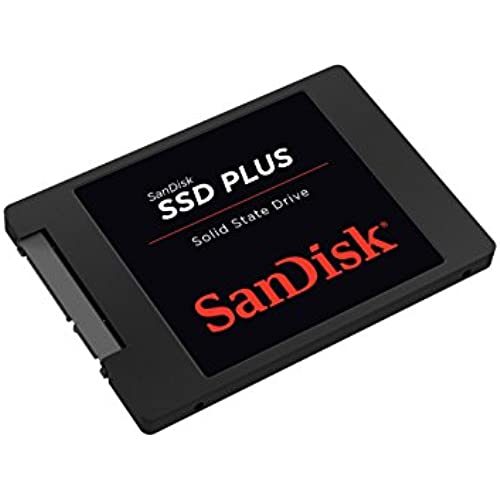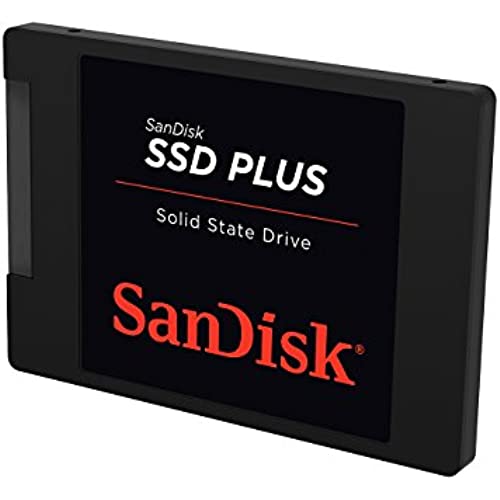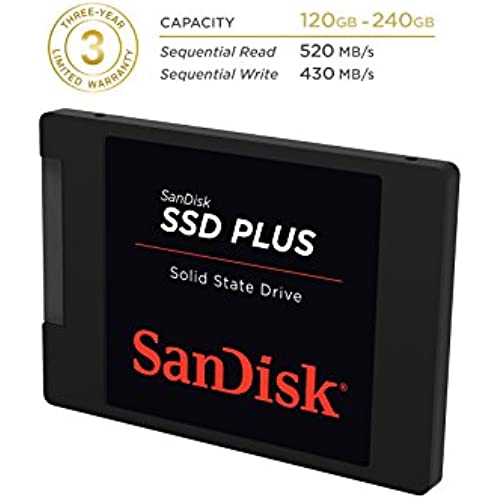







SanDisk SSD Plus 120GB 2.5-Inch SDSSDA-120G-G25 (Old Version)
-

boardgamedude
> 3 dayOverall I am very pleased with this Sandisk SSD. I had previously purchased other brands of SSDs for my personal machines, but a family members hard drive failed in their MacBook, and I decided a SSD fit the bill for a replacement. This particular user hardly uses any disk space. Their old stock drive was less than 25% full, and it was a 200GB drive. So I recommended this SSD, ordered it, and installed it. The user is extremely pleased with is performance. It used to take their Mac over a minute to start, but now it boots in 16 seconds flat. And when it is on and being used, the Macbook flies right along. It was an amazing speed boost. I am very satisfied with this purchase.
-

jr
> 3 dayBought this on sale for $65 to speed up my sluggish Toshiba L15W-B1302 laptop. Was going to do a straight clone of the 500gig 5400 rpm HDD, but opted to do a clean install of Windows 10 via the Microsoft Media Creation tool and an 8 gig thumb drive instead. Which now I have a $10 SATA USB connection cable for no reason. (Changed my mind on the cloning mid-shipment). Everything went smooth w/ Installation of Windows 10. Most of the night spent downloading updates, Steam games, 18 gigs of pictures off the cloud, 10 gigs of music and misc from a memory card transfer. The SSD is a beast compared to the original HDD. Boot up went from around 90 seconds to up and ready to use in 20-25 seconds easy. Apps and Software load up in a snap and saving files feels like I have blazing speed internet. EXTREMELY happy with this purchase. Plan on getting an enclosure for the original HDD and using it for a portable backup/storage.
-

GANBATEKUDASAI
> 3 dayTo start off, I am not techy and just got advice from co-workers and friends on how to revive my 5 year old laptop. The start-ups lagged and programs were slow to boot up. Instead of buying a new laptop, some people suggested to try swap to a SSD. I was apprehensive at first, but with a little on-line research and youtube, I was able to figure out how to do the swap. ITS PLUG AND PLAY!!!! The SanDisk SSD drive slid right into the slot where my old hard drive was and thats it. After reinstalling my OS and programs, my Laptop has a new life!!!! Why spend $$$$$ on a new laptop when I got this for a fraction of the cost and works like a champ! From boot-up to program launches, it is like night and day. Super fast and smooth start-up. I recommend this to anyone with a slightly older laptop and having the same lag issues. Like I said, I am not a computer person, but was able to revive my laptop and super happy with the new performance. Slim design seems to fit most laptop hard drive spaces, although check with your specific model.
-

A.Mallah
> 3 dayI recommend a backup of files, and a fresh install of windows. Use your old HDD for storage and installation of less used programs. If you decide to use this for anything, it should be that you make this your primary drive and install your OS on it. I went from about 120 seconds boot up time to about 20 seconds to a full desktop. Google, SSD vs HDD and you will hit the buy now button. I must tell you, If you have HDD and want to try SSD, buy this and nothing less. More would be better. I quickly filled this up with windows 10 and a few origin games (bf4 ect..). The speed is amazing. I will NEVER use an HDD as my primary EVER again. You should too... Cant wait till 4 tb of this thing is for sale @$100. 10 years ago HDD came with 250gb now 1tb is the standard. my entire pc is faster. EVERYTHING is fast. No joke, even software installed on my secondary HDD is faster. Its as if my ram responds quicker. Hard drives are holding you back. My Rig FX 8350- R9 270X - GSkill ram- the rest is irrelevant.
-

Kaz Ishiya
> 3 dayI bought two of these to use in a couple of older laptops and see what performance I could eke out of them. Neither laptop was cutting edge, so even though this doesnt top the list in terms of performance, its a trusted brand and the price was right (it was cheaper than most other 240GB SSDs at the time of purchase). One went into an old Turion x2 laptop running Windows Vista. Because I didnt have the recovery disc for Vista and I didnt really want to spend too much time with it, I just imaged the drive over using Macrium Reflect to the SSD. It made a huge difference in usability. The boot time is still depressingly slow (but far faster than it used to be -- was over 3 minutes before, now its closer to 60-90 seconds from power button to usable Windows screen), but the responsiveness of the laptop has improved greatly. Also, being a 9 year old laptop with data that we didnt want to lose on it, I figured it was time for a backup anyway, so this way we have the old HDD sitting around as the data backup. The other went into a 1st gen i7 laptop running Windows 7. Unlike the other laptops Id installed 7mm thick SSDs into up until this, this one really required a 9.5mm drive. Thankfully, this SSD (like many others) came with a plastic spacer. With the spacer in place on the SSD, I was able to align the drive and slide it in to the appropriate SATA connectors. I installed Windows 7 fresh on this SSD, and then installed the Windows 10 upgrade on it, figuring that this laptop can now last a number of years. I still have the option of going back to 7 if I hate it, but Microsoft will let me use 10 again at a later date, because its been upgraded before the year period was up. Man, does this laptop boot silly fast now. Its up in just a handful of seconds from power on, and its ready to go. Apps just fly open now. I love it. As Im sure you know just by looking into purchasing an SSD, no matter what laptop you have, if its got an HDD, going to an SSD will provide some benefit. Theres very little downside to SSDs from a performance standpoint. Its mainly price per GB and the data densities available that keep SSDs from being the only thing you see out there. Its definitely headed in that direction, for better or for worse. For my part, Ive been thrilled with my SSDs in my laptops, and these also dont disappoint. Very nice performance, from a solid brand, at a great price. Im happy with that.
-

Charles H. Rau
> 3 dayPros: system is faster when doing a virus scan, and boot time is shorter. Con: I had planned to use an image to load the drive. found out that if the drive where the image was taken is larger than the SSD (which was my case), the image will not install. I had to load from scratch. Not the end of the world, but if you are converting to solid state from a mechanical drive, chances are your mechanical drive will be larger, even if the image of C: is not, and you will not be able to load the image. I gave the product 5 stars because you cant blame the product for ignorance. SanDisk has always been a trusted name.
-

Naturephotoguy
> 3 dayInstalled this SSD on a white MacBook 5.2 as a replacement for the original 120 GB HDD. I was amazed at how easy it is to replace the HDD on these computers, after a long slog replacing the HDD on my 2007 iMac. Disk Utility immediately recognized the SSD, formatted it, and I was able to upgrade the computer to El Capitan and restore the apps and files from Time Machine. All that took longer than the SSD installation, but was simple and straightforward. Watch the videos that OWC has uploaded to YouTube before replacing any HDD in a Mac; they are the best produced and easiest to follow. Result: MacBook now boots in 30 seconds flat; previously took a minute. Apps load almost instantaneously. Would be even faster but the SATA 2.0 in old computers is a bottleneck for data. Wish Id installed an SSD instead of a hybrid drive in the iMac.
-

KeithL
> 3 dayFor the price these are good drives. I picked a few in different sizes up for various machines. 1 of the 2 120GB drives failed hard in under 3 months. Good thing I had them Raid 10. Also have a pair of 480GB so far so good and a pair of 960GB drives. One of the 960GB drives blipped one day and the RAID 1 mirror broke, but it rebuilt fine and so far so good. Performance seems decent, but I am sure the motherboard RAID controller is slowing the drives down. Still from power on to desktop in Windows 10 is about 10 seconds and the machine is immediately usable, vs. spinning disk where you have to wait for everything to finish loading up. I guess I knocked a star for one drive failing so soon and other blipping. Tie will tell how reliable these are. I have revised my rating because while the drives are decent SanDisk support is awful. I have a dead drive and the hoops they make you jump through to get an RMA are unacceptable. Every spinning disk maker just lets you register online, supply info and auto-generates an RMA or even cross ships a drive to you, SanDisk, wants pictures, all sorts of specifics on make and model of computer, and configuration, how many drives in the computer. Really? For a $5 drive it is not worth the grief I might as well eat the cost and buy a new one and I bet they are counting on people doing that. I bought 6 drives for 3 computers, but those will be the last SanDisk drives.
-

Cameron C.
> 3 dayWell I finally got around to the SSD upgrade! It really has made a noticeable difference in performance. I use a Macbook Pro from mid 2010, just using this as a boot drive and it does the job well. Before when I tried to open a heavy app like Pro Tools, Photos, or Photoshop it would just not happen. The computer would freeze and Id be stuck waiting and waiting and waiting. But just now, right before I wrote this interview I opened photos and there it is right away! The macbook boots in 12 seconds flat, Im talking completely off to up and running...12 seconds...seriously. With the platter hdd I had to turn my computer on, then put some water on the stove, and finish up my laundry before it was loaded halfway! Not kidding!! The Sandisk SSD also came with a plastic spacer A.though there were no instructions as to what it actually was, intuition kicked in lmao. I opted not to use it as the macbook has a sort of rubber shock mount for the drive, but time will tell. I had no issues with the installation stemming from the drive itself, but my used macbook didnt have the OEM hdd screws installed. It had phillips head screws that were too short and I could only get two in, but theres OEM parts on the way. If you have externals, or an enclosure for the drive you just replaced, 120gb is more than enough for just a boot drive. DO TURN TRIM ON however, rather important if you want to utilize the entire drive. Theres a free program called Trim Enabler that will do it.
-

April Riney
> 3 day----------------------------------------------------------------------- CrystalDiskMark 3.0.3 Shizuku Edition x64 (C) 2007-2013 hiyohiyo Crystal Dew World :[...] ----------------------------------------------------------------------- Sequential Read : 365.782 MB/s Sequential Write : 301.662 MB/s Random Read 512KB : 230.879 MB/s Random Write 512KB : 275.713 MB/s Random Read 4KB (QD=1) : 19.959 MB/s [ 4872.7 IOPS] Random Write 4KB (QD=1) : 36.161 MB/s [ 8828.3 IOPS] Random Read 4KB (QD=32) : 23.601 MB/s [ 5761.9 IOPS] Random Write 4KB (QD=32) : 85.489 MB/s [ 20871.3 IOPS] Test : 50 MB [Q: 0.9% (2.0/223.4 GB)] (x5) Date : 2016/03/12 19:50:10 OS : Windows 8.1 Pro [6.3 Build 9600] (x64)



